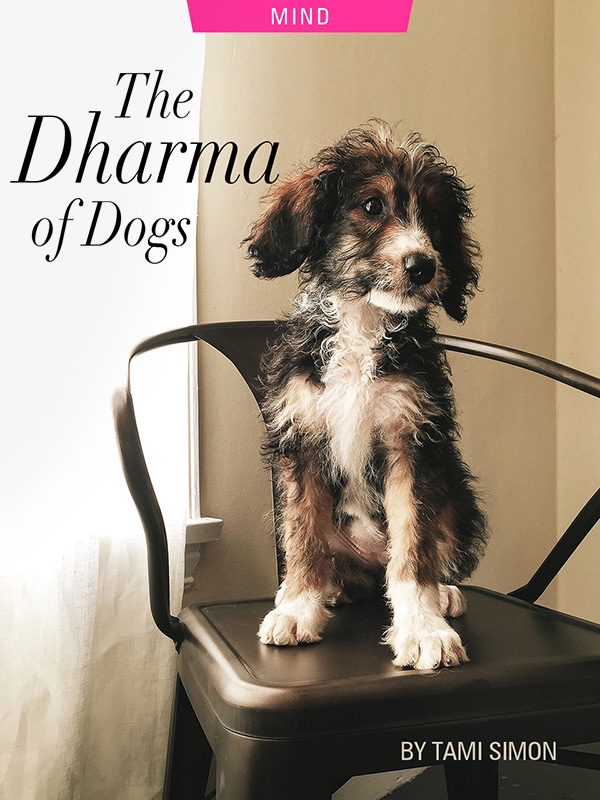
A love story about a woman and her dog, who taught her to open her heart to loving mightily and losing — and then wanting to love mightily again
—
As a young person, I often felt like an alien who was somehow deposited onto planet Earth. From the outside, people couldn’t tell if I was a boy or a girl (or so they said). On the inside, I wasn’t even sure I was human. Humans seemed so coarse to me, and the world so barbaric. I took refuge in ideas and literature and kept my sensitivity and heart locked away in a very secret place.
Many years later — after dropping out of college, traveling to Asia to study meditation, and starting a publishing company called Sounds True — I met Jasmine, a tall, blonde, floppy-eared cocker spaniel. I was thirty-nine years old. By that time, I had found meaningful work and a certain expansive quietness in the practice of meditation. I had also been in several intimate relationships that didn’t quite take root. What I knew was how to meditate, work long hours, and talk about ideas. What I didn’t yet know was how to feel connected and at home on Earth.
Jasmine became a heart teacher and healer for me, hence one of her nicknames: Dr. J.
She wiggled her way right into the center of my heart, breaking through my outer protective shell in a way that forever changed me.
Jasmine came into my life along with Julie Kramer, who has been my partner in love for the past fifteen years and is now my wife. In many ways, my love with Jas (pronounced Jazz) paralleled and was deeply connected to my love with Julie. When they both moved from British Columbia to Boulder to live with me just a few weeks after Julie and I met, their arrival heralded a turning point in my life.
Jas was three-years-old at the time, and not particularly well-behaved. However, she quickly sensed the new love configuration and seemed determined to win me over. And win me over she did. How did this “piglet with a halo” (another one of Jas’s many nicknames) do it? How did she crack a shell nearly four decades strong?
It was the constancy of her love.
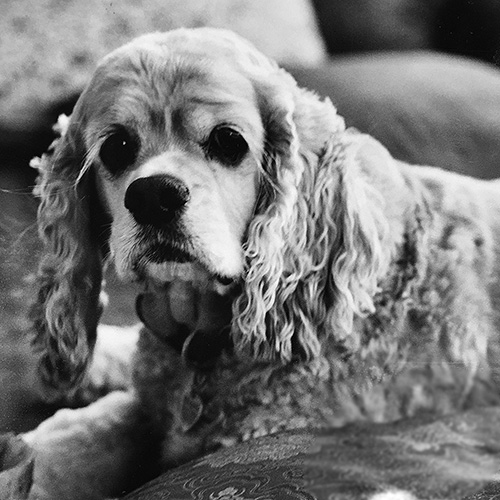
Jas followed me everywhere. Her heart-light was always switched to ‘on’ as she maintained a connection with me, even when we weren’t together. To say she was devoted is an understatement. She followed me into every room. It always amazed me that even when she seemed fast asleep, and even in her old age with total deafness and partial blindness, if I tiptoed out of the room, trying to not disturb her, she would immediately wake up and follow me. Jas had extrasensory sensors that informed her how to fulfill what appeared to be her life mandate: Stay close and connected.
Although Jas came into my life as Julie’s dog, she soon became our dog. I started bringing her to work with me every day at Sounds True where we have a pet-friendly policy such that all well-behaved dogs (and cats and birds, for that matter) are allowed to join their human companions at work. On any given day, there might be one hundred employees at Sounds True along with fifteen to twenty canines, a feline, and occasionally a parakeet or two. From the time Jas was three to the time she was seventeen, she was by my side at work. At one point, I commented that she started to feel like ‘a third leg’ because I always felt her there beside me.
Jas was a continual source of inner brightness for me. She didn’t have to do anything or even not do anything to be such a source. All I had to do was look at her. How did this blonde, floppy-eared cocker spaniel have such an effect on me, even if she was just sleeping or looking out the window?
I believe it was, quite simply, the power of her heart. The power of Jas’s heart activated mine. Her constancy was a sun that melted my guard. Coming into relationship with her devoted dogginess made it safe for me to feel the fullness of my humanness.
Jas lived to seventeen years of age. Toward the end of her life, she was on a host of Chinese herbs and received acupuncture once a week. I would have done anything to keep her alive longer, but at a certain point she developed a brain tumor and it was (more than) obvious that it was her time to leave. When we gave her the injection that would soon stop her heart, Julie, who is a shamanic practitioner, played her frame drum and whistled and sang with the most beatific look on her face, like she was accompanying Jas on some type of ecstatic journey. I, on the other hand, was crumpled over Jas’s body wailing and sobbing. I was not spiritually detached; I was earthly attached to this beautiful body that had warmed the parts of me that were cold. She had befriended me in a way that no one else ever had.
Historically, detachment has been easy for me, as I lean back and observe and know that everything is a flow of impermanence. But this was something different and new, and I gave myself totally to the experience. What I found was that the utter heartbreak that I felt around the loss of Jas opened a gateway in me—a red-hot, aching gateway—that showed me the kind of courage it takes to love with all my might, and to experience profound loss.
Fueling my spiritual search from a young age was a very simple human desire to feel connected, to feel like I belong to this earthly existence.
Jas, with her pure dog heart, was an emissary of the earth. You could say also that she was an emissary of the dharma — the universal teachings about love and generosity and goodness. Through her devotion and friendship, she offered me a way home, a way to be here, instead of defending myself against the pain of being here. She gave me the gift of breaking my heart so I could land on my feet and offer and receive a full embrace.
A mentor of mine said, “The human heart is the only organ that grows stronger through being broken.” Jas’s death broke my heart in the best kind of way. It opened my heart to loving mightily and losing and then wanting to love mightily again.
For some of us — for people like me — dogs carry a certain ‘medicine’, a certain set of healing powers and properties that are unique to them and to their species. Loving and losing Jas and working in close proximity to a menagerie of dogs each day, it became apparent to me that ‘dog medicine’ has certain particular qualities that certain humans need and cherish. What is that medicine and how can we know it and describe it?
Another way to ask this question is, “What is the dharma of dogs?” In Indian philosophy, each one of us is said to possess a particular dharma, a particular purpose and work in the world that is unique to us and of benefit to others. Might there be a dharma for dogs — a particular way that dogs express their innate gifts and fulfill a certain purpose in relationship with human beings?
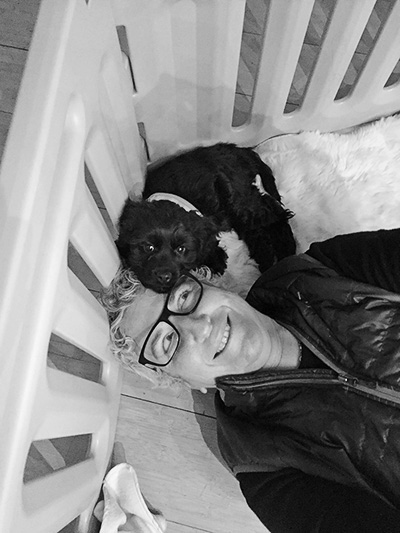
I have a new dog in my life. Her name is Raspberry, although she most often goes by one of her nicknames: Raz (sounds a lot like Jas, huh?), Razzle Dazzle, the Dazzler, or most commonly Razcal. She is a one-year-old, black, curly-haired, mischievous, twenty-two-pound ‘spoodle’ — half cocker spaniel, half poodle. I am still getting to know her and her particular dharma. For one thing, she is an extrovert (Julie and I both are not), and she seems to revel in getting us off the couch to chase her (because she has a shoe or my reading glasses or a pen in her mouth) and take her to the dog park to play with other dogs (where I am asked to interact with other humans and make small talk). Maybe she will teach me how to connect with others in a relaxed and easy way? That would be quite a teaching.
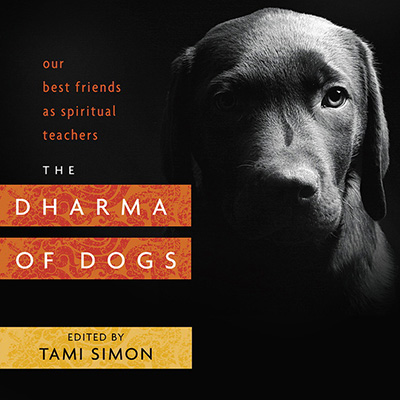
Here for You
(adapted excerpt from The Dharma of Dogs)
By Bonnie Myotai Treace Sensei
I’d spent a week writing in the high woods. A friend of a friend’s North Carolina cabin came complete with “loaner” dog, complete with, shall we say, a “plenitude” of rooster, chicken, and bear decorations and enough personal items in every otherwise-immaculate room that the creepy feeling of having borrowed someone’s shoes was constant. Even the poor dog struck me as one of those too-long-in-boarding vacant souls: anyone will do, throw my ball, food please. I had the mild headache I’d had for six months, and it was time to drive on toward Asheville.
Something had to happen, I knew that. After my second bout with Lyme disease and my supposed recovery the year prior, I’d been a different sort of person. I knew that it was even odd that I thought the lack of connection with the “loaner” dog was an issue with the dog: never in my life had I been unable to sense the heart of an animal. That my impulse was not to take responsibility — to examine what was going on with me and what was possible — was very out of character and had begun with this headache, then continued evolving. I knew the mystery of what was ‘out of order’ physically had to get a better quality of intelligent attention medically, but along the way I had to find the way to re-energize my spiritual life. This was the challenge I gave myself each day and was what I was walking with the next morning in Black Mountain.
It was on that walk that I saw the sign “English Springers Here for You.”
A woman named Heather had set up in someone’s front yard on Cherry Street with eight puppies and several older dogs. I went into the tea shop next door and bought a bag of cookies. “May I lie on the ground and let your puppies jump on me?” I asked. “I can’t buy a dog, but I did bring irresistible cookies.” She laughed, and after a few minutes of heavenly rolling about with the brood, I sat with Heather on the steps drinking glasses of iced tea. As what turned out to be a couple hours of conversation continued, one of her “mother dogs” took up residence by my side, eventually going to sleep on my feet.
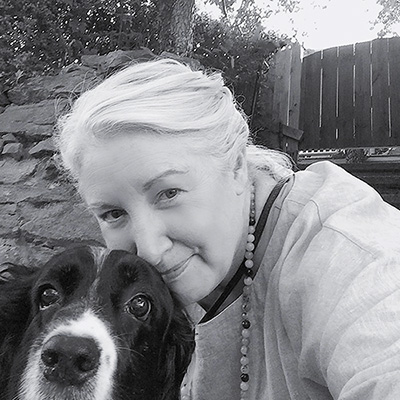
I told Heather that ever since working as Zen clergy with the Red Cross at the Family Assistance Center after 9/11, I’d had a dream of someday having a dog to work with. I’d been involved with debriefing clergy at the end of very difficult days, and I would sometimes point to all we could learn from the therapy dogs. They would position themselves near someone in tremendous pain, with no illusion that they had some wise-enough word to say, and often I’d see a moment when the barrier would fall. A hand would reach out; comfort would be given and received. No barrier, no anxiety about sufficiency. Just love.
Heather said, “I’ve never seen her like this.” The mother dog was looking up at me. I looked back into her eyes. I had a fleeting, disorienting glimmer of feeling like my old, pre-headache self, which made me both want to steal the dog and run for my life. Too strange. Long story short: of course the girl gets the dog. I did explain that I could not possibly take one of the breeding dogs. Heather, it turns out, a good Southern lady, believed the Lord had a plan and this dog and I were part of it. I explained that I genuinely had no money for a dog. But then the friend who had arranged the cabin loan called to check on me, heard the story, loved it, and immediately wired the funds to buy said dog, with vet care for a year. By the end of the day, it was somehow natural as air to continue the drive toward my visit in Asheville — Lady and I sharing a chicken sandwich in the car.
Over the next several years, I would travel to the Mayo Clinic, have surgery to remove a tumor, get a chance to reshape my work, and go on many, many walks with the “English Springer Who is Here for Me.” In the beginning, because I was spending a good deal of time with bags of frozen peas on my quite sore head and trying to keep my nonprofit afloat while sometimes only managing to leave the bed for a few hours a day, Lady was my attendant of sorts. I noticed she had an uncommon sense of humor for a dog, which came in handy on days when drama and darkness knocked at the door. Suddenly there she’d be at the top of the staircase I had no interest in climbing, insisting with a woof that I play “Are You the Dog That Gives Me Pause?” At which point she would thrust her paws over the top stair and howl. Okay. I will cheer up. Okay.
As I got to feeling stronger, Lady indeed got certified as a therapy dog and has had a big life, sleeping on many people’s feet along the way, offering her belly for rubs, and being a gentle and generous friend to hundreds of kids, seniors, folks in hospitals, and every other person walking down the street.
Lady never fails, though, to let me know I’m her One.
If I get up in the morning and start the business of the day without first attending to a real “Hello, glad we’re together! Isn’t it grand?” she reminds me. The wider question stands: how to carry that into all relations, even the ones not as rewarding or softly furred. If she’s been with many people for several hours, I’ll get the look that says, “Let’s head home; I’m not a retriever, after all.” This is our private joke. When she got her therapy-dog certification, the official said to keep an eye out for when she tires of working; she is, after all, “not a retriever.” It is also my shorthand for acknowledging that with the pain pattern I still deal with, I’m not so much a retriever anymore either. (Is anyone?) Meeting that with dog eyes — no barrier, no anxiety about sufficiency, just love — might change everything.
Lady has been on what they call “the last stretch of trail” for a while: nasal cancer. The vets say she won’t see next year. Motto of the house these days is “Every day is a good day,” in the same spirit of teaching as Zen Master Yunmen’s of long ago. Dog eyes, enlightened eyes: what happens when we stop dividing things, ourselves — enough and not enough, life and death?
About the Author:
Bonnie Myotai Treace Sensei is a Zen Teacher and writer who lives with her family in Garrison, New York, and Asheville, North Carolina. She leads meditation and writing retreats. She was the first dharma successor of John Daido Loori, founder of the Mountains and Rivers Order. Myotai’s life as a Zen priest, feminist, poetry professor, and animal lover informs her writing. Myotai is the author of Empty Branches and Winter Moon, both in the Four Seasons of Zen Teachings series. She has contributed chapters to Lotus Moon: The Poetry of Rengetsu; Water: Its Spiritual Significance; The Art of Just Sitting; and The Hidden Lamp: Stories from Twenty-Five Centuries of Awakened Women. Visit 108bowls.org for more information.
You may also enjoy reading Saving Sadie: Loving A Dog With Special Needs… and Paying It Forward by Joal Derse